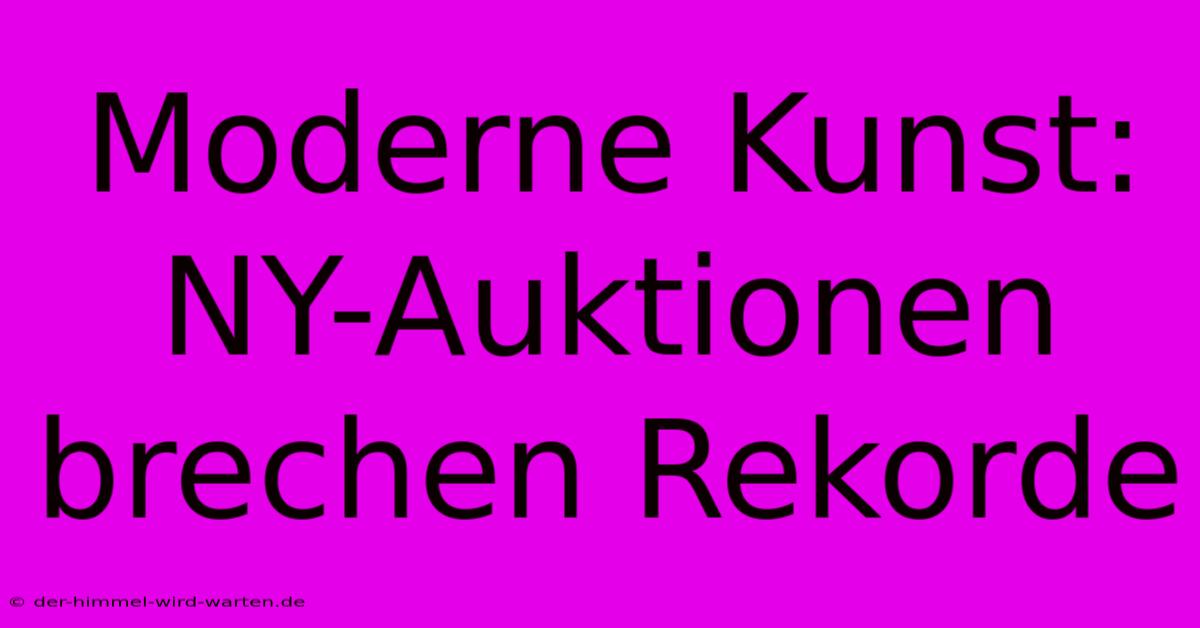Moderne Kunst: NY-Auktionen Brechen Rekorde

Discover more detailed and exciting information on our website. Click the link below to start your adventure: Visit Best Website Moderne Kunst: NY-Auktionen Brechen Rekorde. Don't miss out!
Table of Contents
Moderne Kunst: NY-Auktionen brechen Rekorde
Hey Kunst-Liebhaber! Let's talk about something that's been blowing up lately – the crazy record-breaking prices at modern art auctions in New York City! Seriously, I'm still reeling. I remember a few years ago, I was so sure I'd found the next big thing – a quirky little sculpture I picked up at a flea market for $20. I envisioned it fetching a fortune, maybe even gracing the walls of MoMA. Yeah, about that... it turned out to be a really, really well-made bird bath. Face palm. Lesson learned: Sticking to reputable galleries and understanding the market is way more important than hoping for a lucky find.
Der Wahnsinn der Rekordpreise
This year's auctions in NYC have been absolutely insane. We're talking record-shattering prices for works by established masters and, surprisingly, some exciting new artists too. It's kind of wild to see these pieces going for tens, even hundreds of millions of dollars. I mean, I get it – these are iconic pieces of art history. But still, the numbers are just... whoa. One painting, I can't even remember the artist's name now – my brain's fried from all this info – went for over $100 million! That's more money than I'll ever see in my lifetime. Probably more money than I'll ever imagine seeing.
Was treibt den Markt an?
So, what's fueling this crazy surge in prices? It's a mix of things, really. First, there's the growing demand from ultra-high-net-worth individuals and institutions. Think mega-collectors and museums vying for the most prestigious works. It's supply and demand, but on steroids. There's also the increasing interest in modern and contemporary art as an investment. Some people see it as a safer bet than stocks, even with the volatility. It's a whole different ball game than my bird-bath gamble, that's for sure.
Furthermore, the globalization of the art market plays a huge role. More and more buyers from all over the world are participating in these auctions, driving up competition. It's a global phenomenon, man. This isn't just some local art fair; this is a worldwide phenomenon. Plus, the prestige associated with owning a masterpiece from a major auction house – it's a status symbol, no doubt about it.
Tipps für angehende Kunst-Investoren
Okay, so you're thinking, "I want a piece of this action!" Hold your horses, my friend. Investing in art isn't a get-rich-quick scheme. It takes research, patience, and a good understanding of the market. Here's some advice based on my (many) mistakes:
- Do your research: Before you even think about buying, learn as much as you can. Read art market reports. Study auction results. Understand the artists, the styles, and the historical context. Don't just rely on gut feeling; be methodical.
- Start small: Don't jump in with both feet. Begin by buying smaller, more affordable pieces. You can build your collection over time, learning as you go. Think of it as a marathon, not a sprint.
- Seek expert advice: Talk to art consultants, gallery owners, and experienced collectors. Their insights can be invaluable, even if you have to pay for their expertise. I should have done this.
- Diversify your portfolio: Don't put all your eggs in one basket. Spread your investments across different artists and styles to minimize risk. Don't just buy one artist, my friend.
- Understand the risks: The art market can be volatile. Prices can go up and down dramatically. Be prepared for potential losses, and only invest what you can afford to lose.
In short: The New York art auction scene is on fire. Record-breaking prices are the new normal, driven by a confluence of factors – high demand, global interest, and the prestige factor. But don't let the hype fool you; investing in art requires careful research, patience, and a solid understanding of the risks involved. And for goodness sake, double-check whether that quirky sculpture is actually a bird bath.

Thank you for visiting our website wich cover about Moderne Kunst: NY-Auktionen Brechen Rekorde. We hope the information provided has been useful to you. Feel free to contact us if you have any questions or need further assistance. See you next time and dont miss to bookmark.
Featured Posts
-
Atacms Im Ukrainekrieg Wendepunkt
Nov 20, 2024
-
Kosovo Spiel Abbruch In Rumaenien
Nov 20, 2024
-
Sao Filme Jetzt Im Free Tv
Nov 20, 2024
-
Jaguar Logo Abschied Von Der Raubkatze
Nov 20, 2024
-
Tuerkei Bitterer Rueckschlag Nations League
Nov 20, 2024
